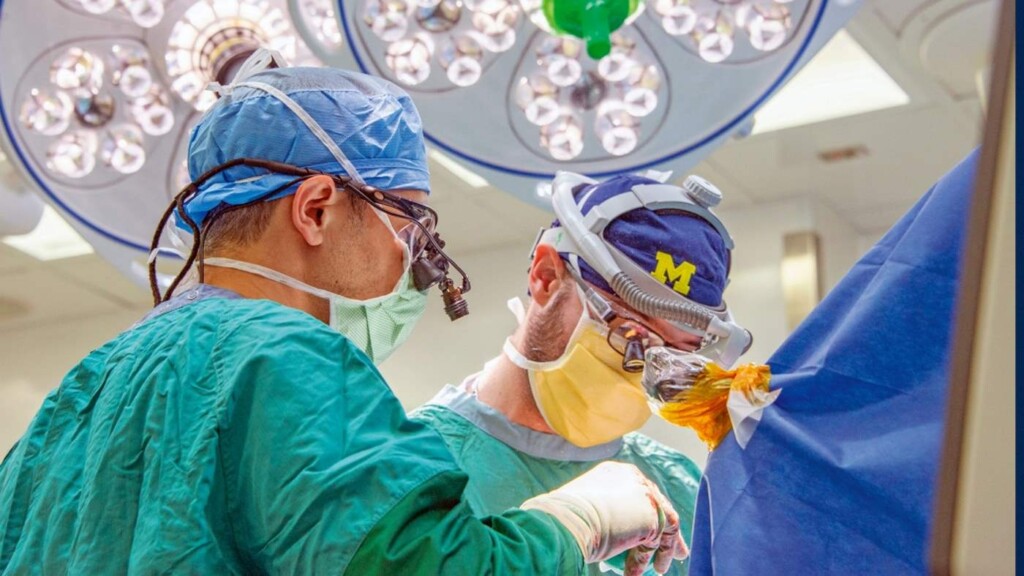

Researchers have developed an AI-powered model that can determine in 10 seconds during surgery whether there is any part of a cancerous brain tumor remaining that could be removed.
The technology, called FastGlioma, far outperformed conventional methods of identifying what remains of a tumor, according to the research team led by the Universities of Michigan and California and the paper they published.
“FastGlioma is an artificial intelligence-based diagnostic system that has the potential to change the field of neurosurgery by immediately improving the overall care of patients with diffuse gliomas. » said lead author Todd Hollon, a neurosurgeon at University of Michigan Health.
“The technology works faster and more accurately than current standard of care methods for detecting tumors and could be generalized to other pediatric and adult brain tumor diagnoses.” This could serve as a fundamental model to guide brain tumor surgery.
When a neurosurgeon removes a potentially fatal tumor from a patient’s brain, he or she is rarely able to remove the entire mass. What remains is called residual tumor.
Typically, the tumor is not detected during surgery because surgeons are not able to differentiate between healthy brain and residual tumor tissue in the cavity where the mass was removed.
Neurosurgical teams employ different methods to locate this residual tumor during a procedure, which may include MRI imaging, which may not be available in the hospital, or a fluorescent imaging agent to identify tumor tissue, which is not applicable to all tumor types.
These limitations prevent their widespread use.
In this international study of AI-based technology, neurosurgery teams analyzed fresh, unprocessed samples from 220 patients undergoing surgery for low- or high-grade diffuse glioma.
FastGlioma detected and calculated the amount of remaining tumor with an average accuracy of approximately 92%.
In a comparison of surgeries guided by FastGlioma predictions or by image- and fluorescence-guided methods, the AI technology missed high-risk residual tumor tissue only 3.8% of the time, compared to a rate of huge failure of 25% for conventional methods.
To assess what’s left of a brain tumor, FastGlioma combines microscopic optical imaging with a type of artificial intelligence called foundation models. These are AI models, such as GPT-4 and DALL·E 3, trained on massive and diverse datasets that can be adapted to a wide range of tasks.
To build FastGlioma, investigators pre-trained the visual base model using more than 11,000 surgical samples and 4 million unique microscopic fields of view.
AI MAKES A DIFFERENCE FOR GOOD: AI safety system stops train after detecting elephants crossing tracks ahead
“FastGlioma can detect residual tumor tissue without relying on tedious histological procedures and large labeled datasets in medical AI, which are rare,” said Honglak Lee, Ph.D., co-author and professor of in computer science and engineering at the University of California. University of Michigan
Acquiring full-resolution images takes approximately 100 seconds, while a low-resolution “quick mode” image takes only 10 seconds. Despite this, the researchers found that fast mode achieved 90% accuracy, just 2% less than full resolution.
“This means we can detect tumor infiltration within seconds with extremely high accuracy, which could inform surgeons if additional resection is needed during an operation,” Hollon said.
AI IN RADIOLOGY: After studying mammograms, AI can detect more breast cancers than humans – with fewer false positives
Over the past 20 years, rates of residual tumors after neurosurgery have not improved.
Residual tumor tissue can lead to poorer quality of life and faster death for patients, but it also increases the burden on a healthcare system that predicts that 45 million annual surgeries will be required worldwide. here 2030.
Not only is FastGlioma an accessible and affordable tool for neurosurgery teams operating on gliomas, but researchers say it can also accurately detect residual tumor for several non-glioma tumor diagnoses, including pediatric brain tumors, such as medulloblastoma and ependymoma, and meningiomas.
AI IN CANCER TREATMENT: Artificial intelligence “can help detect early signs of cancer using chest x-rays”
“These results demonstrate the benefit of visual baseline models such as FastGlioma for medical AI applications and the potential for generalization to other human cancers without requiring extensive model retraining or tuning,” said co -author Aditya S. Pandey, department chair. of neurosurgery at UM Health.
“In future studies, we will focus on applying the FastGlioma workflow to other cancers, including lung, prostate, breast, and head and neck cancers. »
SHARE this positive use of AI with your friends…






